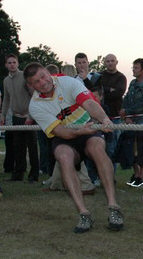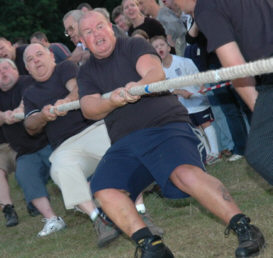Wrapping the rope around the arm can result in a broken bone and loss of blood flow. Wrapping the rope around the wrong part of the body can cause internal injury, and wrapping it around the neck is just ... (yes, people are that stupid).
Spikes and studs in the footware can cause injury when a pull collapses. They can also cause strains and breaks if the feet get stuck in the ground.
When running an informal event it might be tempting to have loops in the rope. I prefer not, due to the risk of someone being unable to release the rope if they need to.

Not like this
An underhand grip, with the arms fully extended, should be used. The grip is only to connect the puller with the rope. If you try to use arm strength you will soon get tired and lose your grip.
Tug of war is not a pulling event but a pushing event: you push with your legs and dragging the rope (and opposition) with you. Keep your arms and body straight so that the full power of your legs are transferred the rope.
Your will need both strength and stamina to win. At the top levels of tug of war, teams may be stationary for for many minutes, locking their position as in arm wrestling. It hurts!

Like this!
Tug of War is a team event which needs all members of the team to work together. There is no point in one member pulling when the others are holding, since he is trying to pull his teams as well as the opposition. All pull together when the coach calls for a pull.
The links below will take you to pages that give some explaination of the rules.
The rope
The ground
The teams
The judges
Site sponsored by and copyright © 2005 of YLE Web Services.